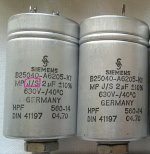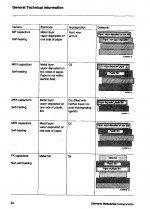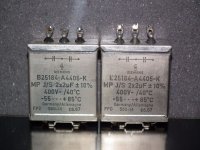They are just now celebrating their 49th birthday. The passive parts division
of Siemens later became EPCOS which is now part of TDK. DIN 41197 is the
German standard they have been designed to. That has been retracted and
cannot be bought anymore.
I would not try to open them; they may contain some oil that is considered
cancer-generating nowadays.
regards, Gerhard
of Siemens later became EPCOS which is now part of TDK. DIN 41197 is the
German standard they have been designed to. That has been retracted and
cannot be bought anymore.
I would not try to open them; they may contain some oil that is considered
cancer-generating nowadays.
regards, Gerhard
Here is information about capacitors that contain "oil that is considered cancer now".
Verzeichnis.pdf — Yandex.Disk
Siemens Type B25040 Capacitor is not listed on that list.
Verzeichnis.pdf — Yandex.Disk
Siemens Type B25040 Capacitor is not listed on that list.
I don’t know what the j/s means, but all electrolytic caps made prior to 1980 are to be suspected of potentially containing pcbs, unless specifically marked.
...all electrolytic caps made prior to 1980 are to be suspected of potentially containing pcbs....
I think you mean "oil" caps.
I never heard of PCB, or any oil, in Electrolytic caps.
(Of course electro made pre-1980 should now be suspected of being dried-out to death...)
True, however if truly unknown, should be treated as such. Most likely just borax and water...
Still wonder what the j/s was for.
Still wonder what the j/s was for.
Maybe J meaning a 5% tolerance. A second letter could be a temperature coefficient.
Sorry: it is10%.
Sorry: it is10%.
Last edited:
As on these capacitors both the maximum voltage and tolerance are written in clear digits, I think that J/S has nothing to do with them. But I can't help either 🙄...
Best regards!
Best regards!
OMG. The brand is Siemens and MP stands for Metallpapier / metal-paper.
J/S could stand for the factory where it was made, for a customer, whatever,
but nothing interesting.
It is a starter cap for a cheap 100W async motor, don't treat it as if it was
something special that needed relics worshipping.
J/S could stand for the factory where it was made, for a customer, whatever,
but nothing interesting.
It is a starter cap for a cheap 100W async motor, don't treat it as if it was
something special that needed relics worshipping.
Last edited:
However, if we talk about a perfect power supply, using a vacuum full-wave rectifier, which capacitors can you recommend for use (without touching upon the question of the advisability of using a tube)?
If not "motor" siemens MP, then what?
If not "motor" siemens MP, then what?
if we talk about a perfect power supply, using a vacuum full-wave rectifier,
Isn't that a contradiction per se?
Best regards!
Not a contradiction. Just inaccurate translation.
That's right: designing and building in the present time of the power supply using vacuum rectifiers for low-power tube amplifier.
That's right: designing and building in the present time of the power supply using vacuum rectifiers for low-power tube amplifier.
OMG. The brand is Siemens and MP stands for Metallpapier / metal-paper.
J/S ...
It is a starter cap for a cheap 100W async motor, don't treat it as if it was
something special that needed relics worshipping.
I don't think so, it’s rated at 600v ... it is more for a tube amplifier.
No. 600VDC is a pretty much standard rating for motor caps. And tube amplifiers don't need anything special.
Looking at the norm description (DIN 41197) it is a motor cap.
Looking at the norm description (DIN 41197) it is a motor cap.
Last edited:
Europe is not 110V land. We had here 220/380Veff, in some countries more.
Add some overvoltage, multiply by 1.414 and see what you get. And a motor
start cap is in series to an inductor. That may yield some extra voltage.
If the cap fails, that results in a disaster; direct short over the mains and the
motor dies, too. That's the reason why they developed self-healing metal
paper capacitors in the first place. The spark vaporizes the metal around
the punch-through hole.
And 2 uF is quite shabby for a plate supply. Even cheap tube radios had
50+50 or 100+100u. There used to be a choke between the two halves,
sometimes the choke doubled as magnet winding of the speaker, before
they had AlNiCo.
Add some overvoltage, multiply by 1.414 and see what you get. And a motor
start cap is in series to an inductor. That may yield some extra voltage.
If the cap fails, that results in a disaster; direct short over the mains and the
motor dies, too. That's the reason why they developed self-healing metal
paper capacitors in the first place. The spark vaporizes the metal around
the punch-through hole.
And 2 uF is quite shabby for a plate supply. Even cheap tube radios had
50+50 or 100+100u. There used to be a choke between the two halves,
sometimes the choke doubled as magnet winding of the speaker, before
they had AlNiCo.
- Status
- Not open for further replies.
- Home
- Design & Build
- Parts
- Siemens capacitor marking


